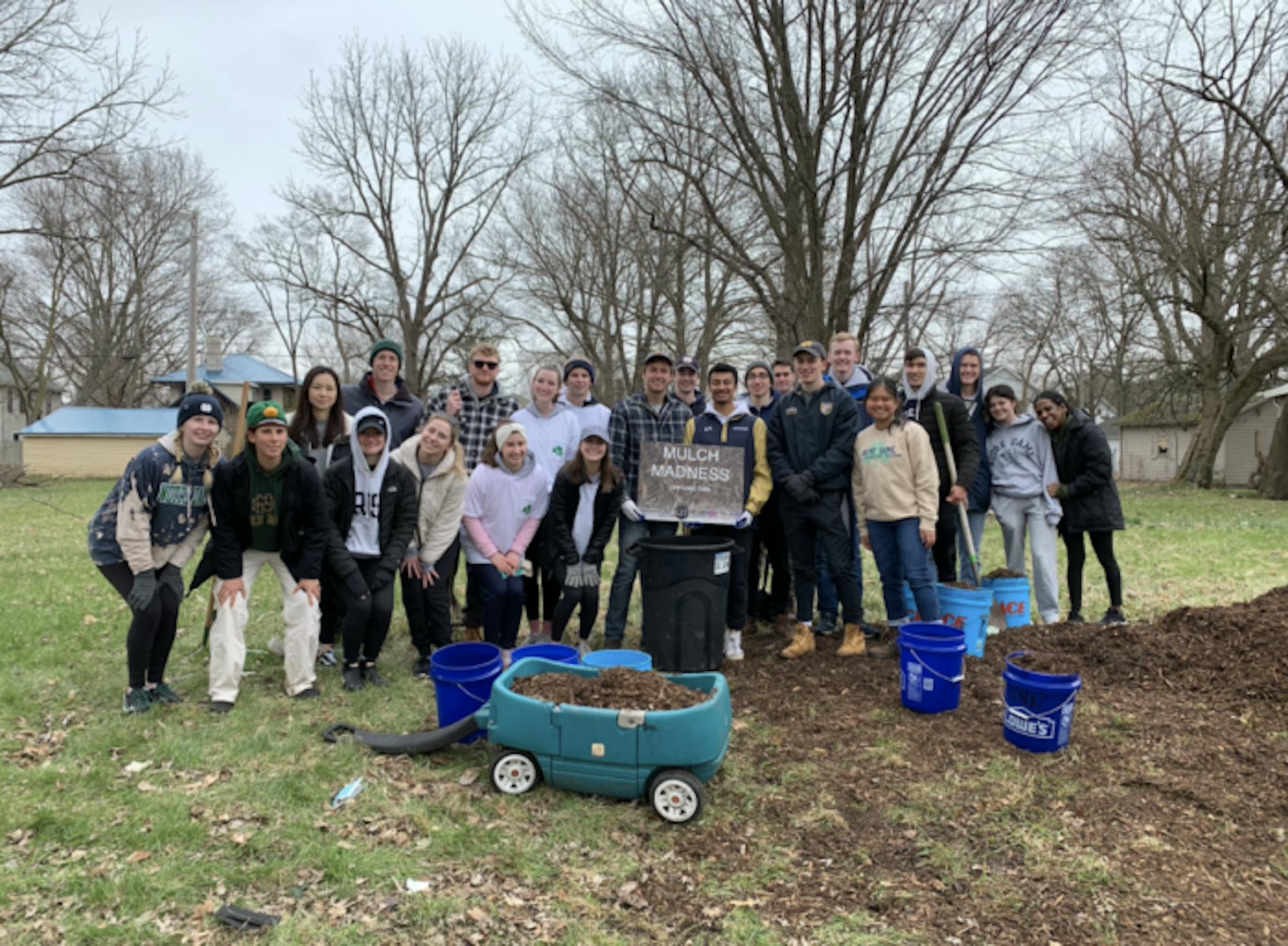Over 300 volunteers braved the cold weather Saturday to participate in Mulch Madness, an annual service project that focuses on mitigating the impact of lead poisoning in South Bend.
Volunteers mulched around contaminated homes in the Near Northwest Neighborhood (NNN) and River Park neighborhood to encase the lead in the soil, shielding children from its toxic effects. In addition, volunteers tested the soil for lead contamination, connected residents with funding and educational resources and organized blood tests to check for lead poisoning with the St. Joseph County Department of Health.
Mulch Madness began in 2016, in response to a Reuters article that compared the rates of lead poisoning across the country to those of Flint, Michigan. Flint made national headlines in 2014 after its children were exposed to lead in contaminated drinking water.
However, Reuters found 2,606 census tracts and 278 zip code areas with a prevalence of lead poisoning at least twice as high as Flint’s at the peak of the crisis.
In one South Bend census tract, 1.5 miles southwest of Notre Dame’s campus, 31% of small children tested from 2005 to 2015 had elevated levels of lead in their blood — more than six times Flint’s rate.
Lead poisoning has been linked to increasedviolent behavior, hyperactivityin youth, slow growth anddevelopment, behavioral challenges andunderperformancein schools.
The article by Reuters identified South Bend as one of the nine hot spots for lead poisoning in the entire nation, according to senior Kyle Moon, the lead organizer for Mulch Madness. To combat this problem, a group of Notre Dame faculty banded together to form the Notre Dame Lead Innovation Team (NDLIT).
NDLIT, co-directed by professor Heidi Beidinger-Burnett of the Eck Institute for Global Health and analytical chemistry professor Marya Lieberman, developed easy-to-use lead screening kits for residents to test the levels of lead contamination in water, soil, dust and paint around their homes.
Moon explained that over 80% of houses in South Bend were built before 1978, the year lead-based paints were banned. When paint chips off of these old houses, it contaminates the soil and harms the children playing in that soil.
Mulching helps to “put a barrier” between the lead in the soil and the child, which mitigates the risk of exposure, Moon said.
Mulch Madness began as a service project to help mulch this “barrier,” but it has expanded in the past few years to become what Moon calls a “lead poisoning prevention event.”
Now, volunteers canvass the neighborhoods beforehand to get consent to mulch and also to share the lead testing kits developed by NDLIT. They also assist residents with applying for funding from the U.S. Department of Housing and Urban Development (HUD). Because South Bend has funding from HUD, households can get up to $15,000 for lead remediation or abatement, but the application process is difficult to navigate without help.
Moon cited the Mulch Madness partnership with the St. Joseph Department of Health as a “major addition this year.”
“The health department had a mobile unit in both neighborhoods, and they were offering blood testing [for lead poisoning] on site, which is huge,” Moon said.
The mobile units helped remove some of the healthcare barriers common in St. Joseph County. Moon explained how factors such as differences in language, lack of accessibility, insurance problems and lack of a trusted provider can prevent people from getting lead poisoning tests, even when they live in high-risk areas.
Moon and 20 team captains prepared for Mulch Madness by knocking on over 200 doors in the NNN and River Park communities and having conversations with residents. They collected soil samples before mulching to compare the lead contamination before and after the event.
The captains also underwent extensive training to allow them to engage with all of the community members and know what they're talking about, Moon said. The training included learning about environmental lead exposure, mulching and why it works, NDLIT’s screening kits and best canvassing practices.
On the day of the event, the volunteers split into teams and covered the soil with six inches of mulch after testing for lead contamination.
Volunteer Kaela Reisch said the atmosphere was “super energetic.”
“It gave us an extra boost and showed the community that we're out here to do good,” she said.
Alix Basden, who volunteered with Mulch Madness last year and became a captain this year, said her favorite part of the event was actually getting to talk to community members.
“That gives you more of a perspective of what people actually experience when they live in areas that have high lead exposure… things I never really thought about,” she said.
This year, Mulch Madness was part of Back The Bend, a Notre Dame-wide day of service organized by student government.
However, Basden said that Mulch Madness was unique compared to the other Back the Bend projects because of its scale.
Moon attributed the size of Mulch Madness to support from the Notre Dame community.
“Putting together an event that's entirely student-run where you have over 300 volunteers should speak to what you can do as a student,” he said. “If you pitch an idea, Notre Dame students rally behind you.”
Moon also emphasized the importance of projects that bridge the gap between community organizing and academic research.
“This is not just some academic model that was developed and then brought into the community. It’s really been co-developed with the people in the community and the local expertise,” he said.
Basden said that events like Mulch Madness serve as a reminder that Notre Dame students are deeply connected to the South Bend community.
“The fact that you only have to drive two or three minutes to get to whatever your site was means that you're always a two or three-minute drive away from the community," she said. "You should always act like it's your hometown."













